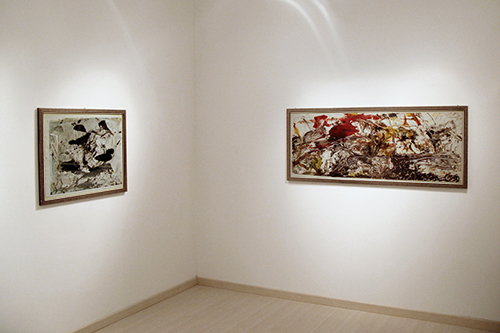
EMILIO VEDOVA
Monotipi
Testo di Luisa Castellini
18 novembre – 18 dicembre 2010
La Galleria Dep Art presenta per la prima volta a Milano una selezione di Monotipi di Emilio Vedova, realizzati nel 2006, anno della scomparsa del Maestro.
È nella pratica del monotipo che prendono corpo gli ultimi lavori di Vedova. Alle spalle i primi esperimenti condotti alla fine degli anni Ottanta con i grandi monotipi che vedono la luce sotto il sole californiano di Santa Barbara e, l’anno successivo, sulla West Coast newyorkese nell’atelier di Garner Tullis. Più avanti, nei primi anni Novanta, Vedova è invece invitato a Spruce-Pine nel North Carolina: nei Rarvey Littleton’s Studios sperimenta l’incisione su vetro giungendo a siglare un proprio modus operandi e a realizzare le sue vetrografie. Queste esperienze e le molte altre che si potrebbero richiamare e la dedizione al monotipo sono saldate in un rapporto di continuità ma, ancor più precisamente, di consonanza. È proprio la natura intima e unica del monotipo, la sua intrinseca complessità pronta ad accogliere infinite variazioni, a configurarlo oltre la prassi tecnica quale medium concreto. Viatico privilegiato del farsi del pensiero di Vedova, un farsi che si attua in quello che lui stesso definisce Spazio Opposto.
Il monotipo, unica impronta di nome e di fatto, ha fisionomia episodica, di evento, al pari della natura e della pittura. È il frutto maturo di una migrazione intuita voluta perseguita su carta di un fluido momento pittorico denso di olio, tempera o inchiostro. Tra l’orizzonte della superficie non assorbente, sia questa vetro, metallo o plexiglass, e il lido cartaceo: il gesto. Ora segno adesso pressione ma comunque fatto lontano da qualsiasi mediazione. A essere consegnato allo sguardo attraverso la calibrata pressione manuale è dunque l’opposto, su carta. A nulla o quasi è concesso albergo sulla superficie prima della composizione, che è quindi supporto, spazio praticabile ma effimero.
Il monotipo respira la propria unicità, il suo farsi oggetto tra le mani quale evento altro. Non contro, ma inverso e contrario. Spazio opposto a quello della pittura, allora, sebbene questa ne sia genesi irrinunciabile ma irrisolta fino alla migrazione, al compiersi sull’altro lido. Luogo interstiziale, per definizione, agito nella propria ambigua fisicità, sonda privilegiata di quella possibilità, in primis semantica, che è carne stessa della pittura, è allora varco, segno liberato dalla servitù dell’essere traccia. La permutazione su carta è teatro di un nuovo evento: tellurico sì ma ancor più sacro. Oltre il tempo dell’ordine – qui Vedova e la pittura – il tempo dell’apertura, del rito e della festa: dell’alterità che si compie nell’alchimia di un gesto antico.
EMILIO VEDOVA
MONOTIPI
Text by Luisa Castellini
18 November – 18 december 2010
The Dep Art gallery presents, for the first time in Milan, a selection of Monotypes by Emilio Vedova realised in 2006, the year of the Master's passing away.
The last pieces by Vedova take on form through the monotype technique. Before these, came his first experiments in this genre from at the end of the Eighties, large monotypes that were revealed under the Californian sun in Santa Barbara, and the following year on the West Coast, in Garner Tullis' atelier in New York. Later, at the beginning of the Nineties, Vedova was invited to Spruce-Pine in North Carolina: in Rarvey Littleton's studios he experimented with glass engraving, achieving a style and method all his own of creating glass monotypes. This experience with the many others that come to mind, and his dedication to the monotype form, fused into a rapport of continuity, or more precisely, of consonance. It is the intimate and unique nature of the monotype, its intrinsic complexity, ready to accommodate infinite variations that, in addition to the form's technical procedures, make it such a concrete medium. A privileged manifestation of Vedova's thoughts, which he himself defined as Spazio Opposto (opposite space).
The monotype, by name and by nature a unique print, has an episodic physiognomy, it is an event, an act of nature, and painterly in equal measures. It is the mature fruit of an intentional intuitional migration, the image on paper of a fluid painterly moment, thick with oil, tempera or ink. Between the horizons of the non-absorbent surface, whether it is glass, metal, or Plexiglas, and the paper beach: the movement. A mark, then pressure, but done far away from any kind of mediation. Brought to our gaze by measured manual pressure, is its opposite, on paper. Nothing, almost, is allowed to sojourn on the surface before composition, making it the support, a practicable but ephemeral space.
A monotype breathes its uniqueness, it becomes an object under the hands creating the event. Not opposing, but inverse and contrary. A space that is opposite to that of painting, even though this provides its indispensable, but unresolved until migration, origin, complete only on that other beach. By definition an interstitial stage, accomplished in its ambiguous physicality, privileged explorer of that possibility, primarily semantic, which is the very flesh of painting, and then crosses the boundary, the markings liberated from the slavery of being tracks. The permutation on paper is the drama of a new event: telluric, yes, but nonetheless scared. Beyond the time of order - here, Vedova and painting - the time of opening, of rites, of festivities: of the alterity that is produced by the alchemy of an antique gesture.